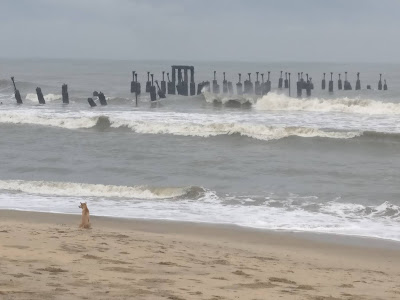A Decade of Travel - 8
2018 – Kozhikode
29th June
It was the last day of the week-long trip along
the Malabar coast to savour the monsoon in full glory. We were in Kozhikode and
I began my day strolling along the wet promenade, easily one of the loveliest
in the country. During the course of the day, one of the driest during our
sojourn, we discovered that Kozhikode was a pretty city inhabited by good people
endowed with loads of civic sense. I haven’t witnessed such traffic discipline
and courtesy anywhere else in the country.
Museums are my weakness. After breakfast we
headed to the Deepanjali Lamp Museum. I was very excited since I also collect
lamps in a small way. The museum was difficult to locate even after arriving at
the destination recommended by Google Maps. We had to use all our ingenuity to
avoid a large puddle occupying 99% of the path leading to the residence housing
the private collection of Prasad. Prasad was taken aback when he saw us,
because it is customary to seek appointment before visiting his private museum.
Nevertheless, he welcomed us warmly and showed around his collection with great
passion. Lamps of every form, material and size filled every nook and corner of
his modest house. They hung on the wall, they stood on the window sills, they
dangled from the ceiling, they were in cabinets and cupboards, even stowed away
under the bed. Prasad, a former lighthouse keeper, explained the intricacies of
some of the lamps and narrated fascinating stories of how he got to acquire them. I
captured this later for an article that was published in The Hindu, most
appropriately during the Deepavali season.
Next stop was Pazhassi Raja Archaeological Museum,
named after the 18th C warrior king, who bravely fought the British,
and is an unsung hero of our independence struggle. The museum housed in a
quintessential Kerala style structure has hoary burial pots and chambers.
In the same complex is another museum dedicated
to the memorabilia of V K Krishna Menon, the controversial defence minister in
Nehru’s cabinet during the 1962 Chinese aggression. The museum has also an art
gallery exhibiting a vast collection of Ravi Varma paintings. Sadly, no
photography is permitted here.
Mishkal Mosque is an exquisite 4-storeyed
wooden structure with no domes or minarets. Originally built in 14th C
by an Arab merchant, it was destroyed by the Portuguese in 1510 and rebuilt by
the Hindu Zamorin in 1578. It is a splendid testimony to the pluralism of
Kerala.
Tali Shiva temple is the oldest (14th
C) and the most revered temple in Kozhikode. Unfortunately, I could not enter
the temple because I could not comply with their strict dress code. The next
hour was spent looking for a store that stocked mundu (veshti).











Comments
Post a Comment